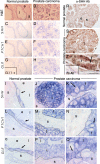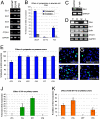Inhibition of prostate cancer proliferation by interference with SONIC HEDGEHOG-GLI1 signaling
- PMID: 15314219
- PMCID: PMC514658
- DOI: 10.1073/pnas.0404956101
Inhibition of prostate cancer proliferation by interference with SONIC HEDGEHOG-GLI1 signaling
Abstract
Prostate cancer is the most common solid tumor in men, and it shares with all cancers the hallmark of elevated, nonhomeostatic cell proliferation. Here we have tested the hypothesis that the SONIC HEDGEHOG (SHH)-GLI signaling pathway is implicated in prostate cancer. We report expression of SHH-GLI pathway components in adult human prostate cancer, often with enhanced levels in tumors versus normal prostatic epithelia. Blocking the pathway with cyclopamine or anti-SHH antibodies inhibits the proliferation of GLI1+/PSA+ primary prostate tumor cultures. Inversely, SHH can potentiate tumor cell proliferation, suggesting that autocrine signaling may often sustain tumor growth. In addition, pathway blockade in three metastatic prostate cancer cell lines with cyclopamine or through GLI1 RNA interference leads to inhibition of cell proliferation, suggesting cell-autonomous pathway activation at different levels and showing an essential role for GLI1 in human cells. Our data demonstrate the dependence of prostate cancer on SHH-GLI function and suggest a novel therapeutic approach.
Figures



Similar articles
-
Perlecan, a candidate gene for the CAPB locus, regulates prostate cancer cell growth via the Sonic Hedgehog pathway.Mol Cancer. 2006 Mar 1;5:9. doi: 10.1186/1476-4598-5-9. Mol Cancer. 2006. PMID: 16507112 Free PMC article.
-
Hedgehog signaling promotes prostate xenograft tumor growth.Endocrinology. 2004 Aug;145(8):3961-70. doi: 10.1210/en.2004-0079. Epub 2004 May 7. Endocrinology. 2004. PMID: 15132968
-
Unique and complimentary activities of the Gli transcription factors in Hedgehog signaling.Exp Cell Res. 2006 Jul 1;312(11):1925-38. doi: 10.1016/j.yexcr.2006.02.019. Epub 2006 Mar 29. Exp Cell Res. 2006. PMID: 16571352
-
Therapeutic targeting of the Hedgehog-GLI pathway in prostate cancer.Cancer Res. 2005 Apr 15;65(8):2990-2. doi: 10.1158/0008-5472.CAN-05-0439. Cancer Res. 2005. PMID: 15833820 Review.
-
Interference with HH-GLI signaling inhibits prostate cancer.Trends Mol Med. 2005 May;11(5):199-203. doi: 10.1016/j.molmed.2005.03.004. Trends Mol Med. 2005. PMID: 15882606 Review.
Cited by
-
FOXA1: a transcription factor with parallel functions in development and cancer.Biosci Rep. 2012 Apr 1;32(2):113-30. doi: 10.1042/BSR20110046. Biosci Rep. 2012. PMID: 22115363 Free PMC article. Review.
-
Integrated Hedgehog signaling is induced following castration in human and murine prostate cancers.Prostate. 2013 Jan;73(2):153-61. doi: 10.1002/pros.22550. Epub 2012 Jul 2. Prostate. 2013. PMID: 22753310 Free PMC article. Clinical Trial.
-
Overexpression of Gli1 in cancer interstitial tissues predicts early relapse after radical operation of breast cancer.Chin J Cancer Res. 2012 Dec;24(4):263-74. doi: 10.3978/j.issn.1000-9604.2012.10.04. Chin J Cancer Res. 2012. PMID: 23358704 Free PMC article.
-
Hypoxia-Induced Signaling Promotes Prostate Cancer Progression: Exosomes Role as Messenger of Hypoxic Response in Tumor Microenvironment.Crit Rev Oncog. 2015;20(5-6):419-34. doi: 10.1615/CritRevOncog.v20.i5-6.130. Crit Rev Oncog. 2015. PMID: 27279239 Free PMC article. Review.
-
Role of Protein Kinases in Hedgehog Pathway Control and Implications for Cancer Therapy.Cancers (Basel). 2019 Mar 29;11(4):449. doi: 10.3390/cancers11040449. Cancers (Basel). 2019. PMID: 30934935 Free PMC article. Review.
References
-
- Ingham, P. & McMahon, A. (2001) Genes Dev. 15, 3059–3087. - PubMed
-
- Ruiz i Altaba, A., Sanchez, P. & Dahmane, N. (2002) Nat. Rev. Cancer 2, 361–372. - PubMed
-
- Pasca di Magliano, M. & Hebrok, M. (2003) Nat. Rev. Cancer 3, 903–911. - PubMed
-
- Hahn, H., Wicking, C., Zaphiropoulous, P. G., Gailani, M. R., Shanley, S., Chidambaram, A., Vorechovsky, I., Holmberg, E., Unden, A. B., Gillies, S., et al. (1996) Cell 85, 841–851. - PubMed
-
- Johnson, R. L., Rothman, A. L., Xie, J., Goodrich, L. V., Bare, J. W., Bonifas, J. M., Quinn, A. G., Myers, R. M., Cox, D. R., Epstein, E. H., Jr., & Scott, M. P. (1996) Science 272, 1668–1671. - PubMed
Publication types
MeSH terms
Substances
Grants and funding
LinkOut - more resources
Full Text Sources
Other Literature Sources
Medical
Research Materials
Miscellaneous

